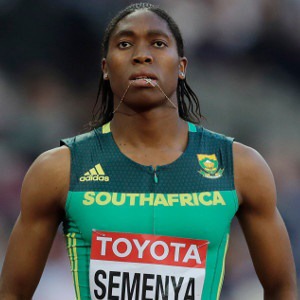LONDON, (Reuters) – South African Caster Semenya’s long and controversial reign as the queen of middle distance running looks set to be ended this year not by a track rival but by a new hyperandrogenism rule that will stop her from running 800 and 1500 metres races.
The IAAF will publish new rules today to prevent women with the condition, which produces higher than normal levels of testosterone and is deemed by the governing body to give them an unfair advantage, from running distances from 400m to the mile.
The International Association of Athletics Federations would allow them to compete at international level only if they took medication to reduce naturally occurring levels of testosterone.
Semenya, double Olympic and triple world champion over 800m and who completed the 800-1500 double at the Commonwealth Games this month, has always been a controversial figure in the sport as its authorities have sought a solution that respected her rights while also providing a “level playing field”.
The 27-year-old’s powerful physique and deep voice, followed by the revelations of her hyperandrogenism, left some rivals complaining that they faced an impossible and unfair challenge.
The IAAF’s previous attempts to regulate the issue fell foul of a Court of Arbitration for Sport ruling in 2015 following an appeal on behalf of Indian athlete Dutee Chand, who had been banned from competing because of her testosterone levels.
The IAAF Council announced last month that following a review of available evidence it would revise its regulations, with the changes coming into force on Nov. 1. “All testosterone, either naturally occurring or artificially inserted into the body, provides significant performance enhancements,” IAAF head Seb Coe said at the time, while also going out of his way to stress that nobody was suggesting Semenya had done anything wrong.
“We were asked by CAS to provide evidence of the magnitude of the advantage, which we now have,” he said.
FEMALE CLASSIFICATION
Media in the UK and South Africa yesterday published sections of the report ahead of its official release, revealing that the new hyperandrogenism regulations would include a separate female classification to be known as an Athlete with Differences of Sexual Development (DSD).
“Experts consulted by the IAAF have gathered and reviewed all of the published evidence and data, which indicates that increasing the level of circulating testosterone from the normal female range to the normal male range leads to increased muscle mass and strength and higher haemoglobin levels,” the report, which has not been seen by Reuters, is reported to have said. “The result is these new regulations, which seek to facilitate the participation in the sport of athletes with DSDs on terms that preserve fair and meaningful competition in the female classification.
“The significant over-representation of DSD athletes in certain events, and their success in those events, provides further indirect but strong corroboration of the above.
“In addition, the IAAF has gathered observational data about the difference in performance levels of DSD athletes depending on whether or not their testosterone levels are suppressed.”
The IAAF’s medical advisors have suggested the advantage held by DSD athletes is far less pronounced in short sprints or longer distance endurance races, leaving the door open for Semenya to move up to 5,000 or 10,000 metres if she desires.
The South African began raising eyebrows when she won the world junior championships in 2008 and the senior world title the following year, with dramatic improvement in her times.
The IAAF made Semenya take a sexual verification test, which was initially kept secret but revealed by the media in 2009. Since then virtually all of Semenya’s performances have been followed by questions about her sexual and physical status, but she has long stopped answering them.
Reuters yesterday sought Semenya’s response to the IAAF’s decision through her manager but he did not immediately reply.










